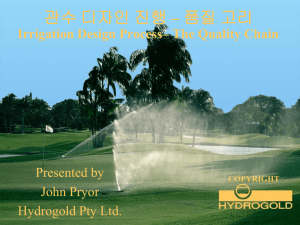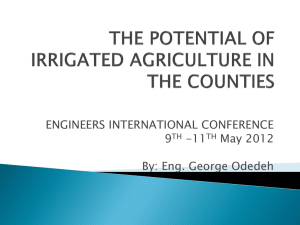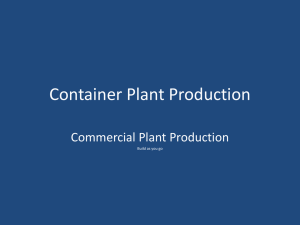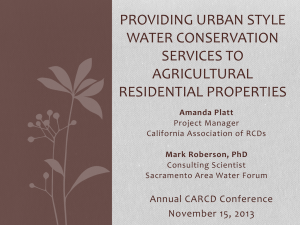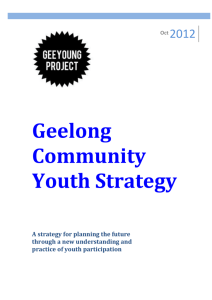Presentation
advertisement
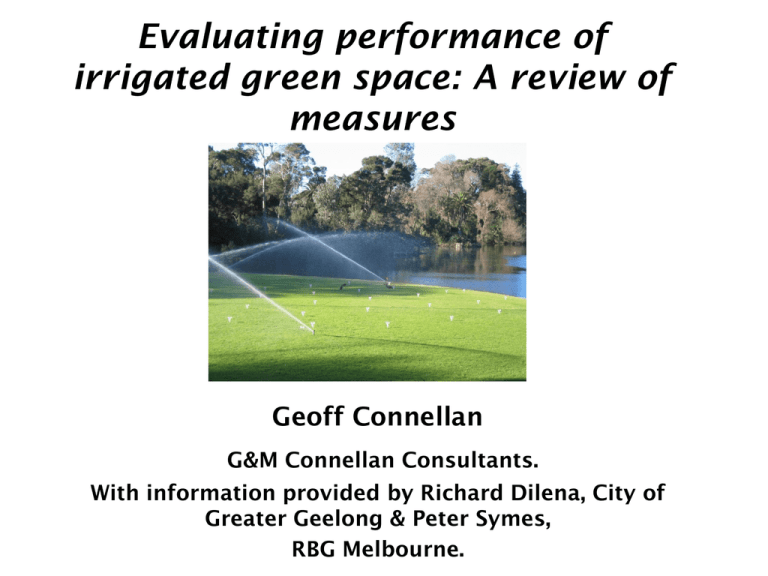
Evaluating performance of irrigated green space: A review of measures Geoff Connellan G&M Connellan Consultants. With information provided by Richard Dilena, City of Greater Geelong & Peter Symes, RBG Melbourne. There are lots of efficiency terms. Including Water Use Efficiency (WUE) Ref: Irrigation Insights No 5. Fairweather, Austin & Hope, NSW Ag. NPSI WUE “commonly used to describe the relationship between water (input) and the agriculture product” WUE is an Index WUE is used as a generic label for any performance indicators used to study water use in “crop production”. Water Use and Irrigation Efficiencies 1. Water Use Efficiency Measure of Landscape Outcomes delivered per unit of water input. Strategy: Reduce plant water demand, E.g. Low water use/efficient species 2. Irrigation Efficiency Proportion of the water applied, that is delivered into the plant root zone. APPLICATION EFFICIENCY OVERALL IRRIGATION EFFICIENCY SCHEDULING EFFICIENCY IRRIGATION EFFICIENCY How much water gets into the root zone ? Aim: Efficient Delivery into High Application Efficiency Root Zone Aim: High Scheduling Efficiency Depth and Timing matched to daily ET ET Factors affecting Application Efficiency Efficiency Demands Uniformity Assessment Individual Sprinkler Heads 1. Individual heads popped up 2. Heads assessed according to the potential fault categories: Uniformity Testing Auditing – The Can Test NOTE This discussion is based on Field or Operational performance measures. *Scheduling Coefficients (SC) and also *Christiansen Coefficient (CU) are important, particularly in terms of the design of systems. Uniformity Testing - Calculating Field DU DU (%) = M25 M x 100 Where: M - average value of all catch can readings. M25 - average of lowest 25% of readings. *Field DU should be greater than 75%. Precipitation Rate (PR) (a) Determined from a can test also (b) Calculated from sprinkler flow rate Valuable data * Validate system performance * Determine Irrigation Schedule Calculating Precipitation Rate Depth (mm) Catch can - A very powerful performance tool! Uniformity of Application Can test readings – Volume (mL) 28 33 28 23 40 34 14.5 54 D C 22 23.5 34 35 B 12 30 34 20 A 4 3 2 1 ROWS Lowest: 12 mL Highest: 54 mL Uniformity Results For example: New irrigation systems: Field DU Should be > 75% Existing systems: If DU < 75% System should be repaired or adjusted. Existing systems: If DU < 60% System should be replaced. DU as an Efficiency Measure It is not strictly a measure of efficiency. It is an Index Does it matter? (1)For communication and management – No. (2) For scientific analysis and water balance – Yes. It is the distribution of water in the soil that is important ! Soil Type Sprinkler Type Catch Can DULQ Soil Moisture at 12 cm DULQ Soil Moisture at 20 cm DULQ Sandy Loam Rotor 57% 75% 77% Silty clay loam Rotor 68% 86% 87% Comment: DU as an Efficiency Measure Example – Low DU and High Efficiency System with poor uniformity, application depth less that that required to refill the root zone, all the water taken up by plant roots. It is High Efficiency! (By some measures) RBG System Fix - Before Before DULQ : 55% SC 25%: 1.81 81% extra water required. 10.0 9.4 9.0 8.1 7.8 8.0 7.2 6.8 7.0 6.3 5.0 5.9 5.5 4.3 4.6 5.9 5.0 4.8 4.4 5.0 3.9 3.7 4.0 Series1 3.1 3.0 1.8 2.0 2.0 1.0 Can Number Can 20 Can 19 Can 18 Can 17 Can 16 Can 15 Can 14 Can 13 Can 12 Can 11 Can 10 Can 9 Can 8 Can 7 Can 6 Can 5 Can 4 Can 3 Can 2 0.0 Can 1 mm 6.0 RBG System Fix - After 9.0 8.5 7.8 8.0 6.0 8.0 7.4 7.0 7.0 6.5 6.3 5.5 6.3 6.8 6.1 5.5 6.8 6.8 6.7 6.3 6.3 6.5 5.5 5.0 5.0 4.0 Series1 3.0 2.0 1.0 Can Number Can 20 Can 19 Can 18 Can 17 Can 16 Can 15 Can 14 Can 13 Can 12 Can 11 Can 10 Can 9 Can 8 Can 7 Can 6 Can 5 Can 4 Can 3 Can 2 0.0 Can 1 mm After DULQ 79% SC 25% 1.26 26% extra water required Measurement of Water Use All irrigated sites need to have dedicated water meters. Central control and PC based systems, together with digital . flow meters, provide comprehensive water use data. Reporting Water Consumption 1. Volume totals – ML 2.Trends and Reference years - % change, higher, lower 3. Application Rates (ML/ha) compared to industry standard. * Greater exposure of Application Rates would be beneficial. Water Use Reporting Water Budget Water Used Water Required 7 6 5 4 Series1 3 2 1 0 1 2 3 Water Use Reporting Water Budget Water Used Water Required - Average - Meter - Actual Inefficiency 7 6 5 4 Series1 3 2 1 0 1 2 3 Irrigation Index – Efficiency Indicator The Irrigation Index (Ii) What is: Water used relative to Water required (volume)? . Reporting Water Use Performance Irrigation Index RBG Melbourne 4 250000 Irrigation Annual Meter Total (kl) 3.5 Irrigation Index 3 200000 150000 2 1.5 100000 1 50000 0.5 Financial Year 2009-10 2008-09 2007-08 2006-07 2005-06 2004-05 2003-04 2002-03 2001-02 2000-01 1999-00 1998-99 1997-98 1996-97 1995-96 0 1994-95 0 *1993-1994 Kilolitres 2.5 Irrigation Index 300000 Case Study Reserve Irrigation Report Richard Dilena City of Greater Geelong Bakers Reserve, Geelong, Jan 2012 Bakers Reserve, Geelong, Jan 2013 Bakers Reserve, Geelong, Jan 2014 Bakers Reserve Irrigation Report Bakers Reserve Irrigation Report Bakers Reserve Irrigation Report Bakers Reserve Irrigation Report Anakie Reserve Irrigation Report Anakie Reserve Irrigation Report Anakie Reserve Irrigation Report Sample: Irrrigated site report Richard Dilena, City of Greater Geelong Performance Parameters 1. Irrigation index 2. Irrigation efficiency 3. Visual assessment 4. % of water budget used Irrigation index 0.9 > 1.1 nderwatering < 0.9 overwatering > 1.1 ideal Irrigation efficiency index ideal 0.95 to 1.05 minor variation +/- 5% major variation +/- 10% or more Visual assessment % site water budget used ideal +/- 10% minor +/- 20% major > 20% 1 worse than crop circles 2 crop circles 3 large degree of pattern 4 minor degree of pattern 5 completely even v/poor poor good v/good excellent Sample: Irrrigated site report Richard Dilena, City of Greater Geelong Site Irrigtaion index (Ii) Anakie Reserve 1.01 Bakers Reserve 0.86 rwon Heads Village1.06 Park Breakwater Reserve 1.17 Burdoo Reserve 0.90 Collendina Reserve 0.90 Drysdale Reserve0.81 Elderslie Reserve0.96 Flinders Peak 0.82 Frier Reserve 0.96 Grinter Reserve 1.03 Grovedale Reserve0.98 Hamlyn Park 1.14 Irrigation Efficienc Irrigation yEfficienc Irrigation estimate y - actual Efficienc (IE) y index d (IEe) 75% 74% 0.99 80% 93% 1.16 75% 71% 0.95 75% 64% 0.85 75% 84% 1.12 80% 89% 1.11 65% 82% 1.26 75% 79% 1.05 75% 92% 1.23 80% 83% 1.04 80% 78% 0.98 80% 82% 1.03 80% 70% 0.88 % of Site Water Budget used Visual assessme nt 95% 117% 95% 102% 90% 81% 72% 90% 77% 87% 92% 88% 103% 2 2 3 2 5 3 3 3 2 4 4 2 3 It is more than the water! What is the performance of the green space? Benefits and Value of Irrigated Green Space (1) Social (2) Environmental (3) Economic Physical Health Recreation - Green Space Active Recreation Passive Recreation Social Benefits: “User hours or player hours” Identifying Services or Outcomes Provided. Example: Redleap Reserve, Whittlesea Services provided: AFL Cricket Total: 11,500 Player hours 6,700 Player hours 18,200 Player hours Water productivity: 3,600 player hours per ML Exercise/Recreational Benefits Dept. Health, Vic. Boeing Reserve, City of Moonee Valley Stormwater development of site. Sporting ovals, baseball, grasslands, woodlands Health Benefits from Green Space Physical health benefits: $400,000 (Approx.) per year Other health benefits • Mental health: Reduction in stress levels. • Social benefits: Social cohesion, Liveability, Reduced rates of violence. • Environmental benefits: Urban heat island (UHI) mitigation Cost Benefit Analysis – Green space Evaluated over 10 years Community benefit: $4 million (Approx.) Environmental benefit: $185,000 (Approx. Costs: $3 million (Approx.) Net benefit of green space: $0.8 million RBG Melb. Irrigation Water Productivity 70 Litres per visitor. Photo: Jorge de Arujo, RBG What is the $ value of the benefits? Efficiency Reference Water Use Efficiency For Irrigated Turf and Landscape Geoff Connellan CSIRO Publishing Website: http://www.publish.csiro.au/pid/5263.htm Summary 1. DU is a powerful measure – It describes the condition of the system and is an effective communication tool. 2. Irrigation Index (Ii) - Assesses irrigation management, scheduling and overall efficiency. 3. Precipitation rate (PR) is valuable in terms of application efficiency and also in gaining an understanding of the hydraulic performance of the system 4. Productivity measures, which assess the services of the green space, are becoming increasingly important as the value of green space is recognised.


